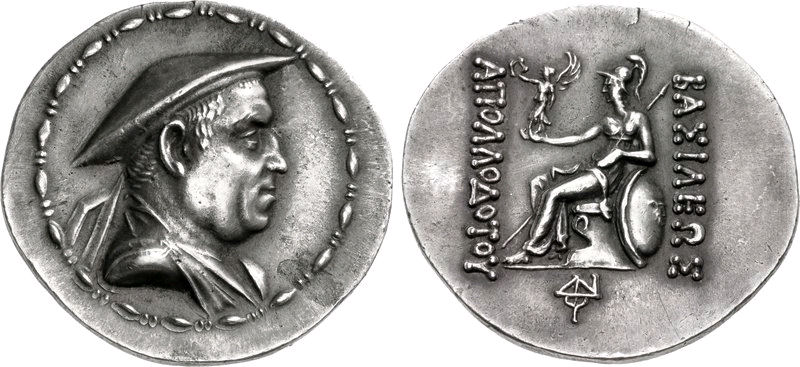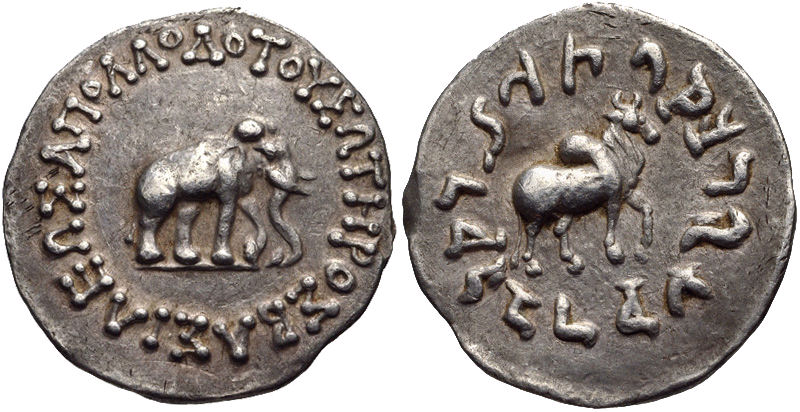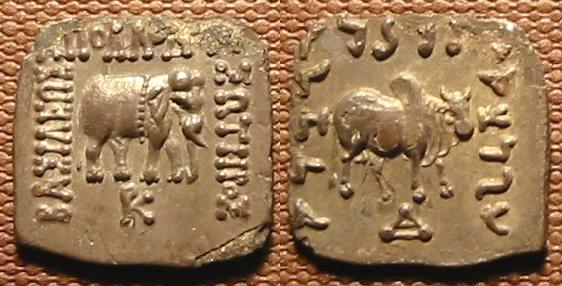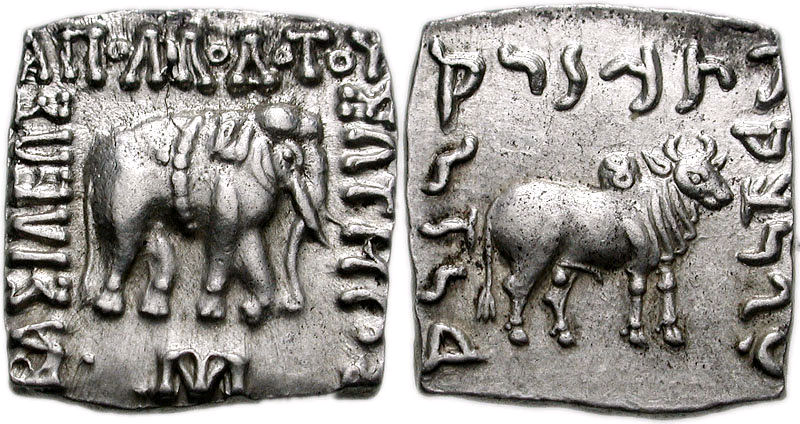Apollodotus I on:
[Wikipedia]
[Google]
[Amazon]
 Apollodotus I ( Greek: ) Prakrit in the
Apollodotus I ( Greek: ) Prakrit in the

 The coinage of Apollodotus is, together with that of Menander, one of the most abundant of the Indo-Greek kings. It is found mainly in the provinces of Punjab, Sindh and Gujarat, indicating the southern limit of the Indo-Greek expansion in India. This is also suggested by the Periplus, a 1st-century AD document on trade in the Indian Ocean, which describes the remnants of Greek presence (shrines, barracks, wells, coinage) in the strategic port of Barygaza (
The coinage of Apollodotus is, together with that of Menander, one of the most abundant of the Indo-Greek kings. It is found mainly in the provinces of Punjab, Sindh and Gujarat, indicating the southern limit of the Indo-Greek expansion in India. This is also suggested by the Periplus, a 1st-century AD document on trade in the Indian Ocean, which describes the remnants of Greek presence (shrines, barracks, wells, coinage) in the strategic port of Barygaza (

 Before their design was eventually simplified, some of the earlier coins of king Apollodotus directly associate the elephant with Buddhist symbolism, such as the stupa hill (
Before their design was eventually simplified, some of the earlier coins of king Apollodotus directly associate the elephant with Buddhist symbolism, such as the stupa hill (
/ref> The same association was made later on coins of
Coins of ApollodotusMore coins of Apollodotus
{{DEFAULTSORT:Apollodotus I Indo-Greek kings 2nd-century BC Indian monarchs Year of birth unknown 160s BC deaths
 Apollodotus I ( Greek: ) Prakrit in the
Apollodotus I ( Greek: ) Prakrit in the Kharoshti
The Kharoṣṭhī script, also spelled Kharoshthi (Kharosthi: ), was an ancient Indo-Iranian script used by various Aryan peoples in north-western regions of the Indian subcontinent, more precisely around present-day northern Pakistan and e ...
script: ''maharajasa apaladatasa tratarasa'') was an Indo-Greek king between 180 BC and 160 BC or between 174 and 165 BC (first dating Osmund Bopearachchi
Osmund Bopearachchi (born 1949) is a Sri Lankan historian and numismatist who has specialized notably standardized the coinage of the Indo-Greek and Greco-Bactrian kingdoms. He is currently Emeritus Director of the CNRS at the École Normale Supé ...
and R. C. Senior, second dating Boperachchi) who ruled the western and southern parts of the Indo-Greek kingdom, from Taxila
Taxila or Takshashila (; sa, तक्षशिला; pi, ; , ; , ) is a city in Punjab, Pakistan. Located in the Taxila Tehsil of Rawalpindi District, it lies approximately northwest of the Islamabad–Rawalpindi metropolitan area a ...
in Punjab to the areas of Sindh and possibly Gujarat.
Ruler of the Indo-Greek kingdom
Apollodotus was not the first to strike bilingual coins outside Bactria, but he was the first king who ruled in India only, and therefore the founder of the proper Indo-Greek kingdom. According to W. W. Tarn, Apollodotus I was one of the generals ofDemetrius I of Bactria
Demetrius I Anicetus ( grc, Δημήτριος Ἀνίκητος, Dēmētrios Anikētos, "the unconquered"), also called Damaytra was a Greco-Bactrian and later Indo-Greek king (Yona in Pali language, "Yavana" in Sanskrit) (reigned c. 200–167 B ...
, the Greco-Bactrian king who invaded northwestern India after 180 BC. Tarn was uncertain whether he was a member of the royal house. It is possible he was an illegitimate son of Euthydemus, making him Demetrius’ half brother. Later authors largely agree with Tarn's analysis, though with perhaps even more uncertainty regarding who the king was, for his coins do not give many hints.
Apollodotus was either succeeded in India by Antimachus II
Antimachus II Nikephoros (Greek: ; the epithet means "the Victorious") was an Indo-Greek king. He ruled a vast territory from the Hindu-Kush to the Punjab around 170 BCE. He was almost certainly the eponymous son of Antimachus I, who is known fro ...
, or the two kings were contemporary, Antimachus II ruling the more western territories closer to Bactria. Eventually Apollodotus I was succeeded by Menander I, and the two kings are mentioned by Pompejus Trogus as important Indo-Greek rulers.
The 1st-2nd century AD '' Periplus of the Erythraean Sea'' further testifies to the reign of Apollodotus I and the influence of the Indo-Greeks in India:
Coinage

Bharuch
Bharuch (), formerly known as Broach, is a city at the mouth of the river Narmada in Gujarat in western India. Bharuch is the administrative headquarters of Bharuch District.
The city of Bharuch and surroundings have been settled since tim ...
) in Gujarat. Strabo (XI) also describes the occupation of Patalene ( Indus Delta country). While Sindh may have come under his possession, it is not known whether Apollodotus advanced to Gujarat, where the Satavahanas ruled.
Apollodotus also issued a great number of bilingual Indian-standard square coins. Besides the usual royal title, the exact significance of the animals depicted on the coins is unclear. The sacred elephant may be the symbol of the city of Taxila
Taxila or Takshashila (; sa, तक्षशिला; pi, ; , ; , ) is a city in Punjab, Pakistan. Located in the Taxila Tehsil of Rawalpindi District, it lies approximately northwest of the Islamabad–Rawalpindi metropolitan area a ...
, or possibly the symbol of the white elephant who reputedly entered the womb of the mother of the Buddha
Siddhartha Gautama, most commonly referred to as the Buddha, was a wandering ascetic and religious teacher who lived in South Asia during the 6th or 5th century BCE and founded Buddhism.
According to Buddhist tradition, he was born in Lu ...
, Queen Maya
Queen Māyā of Shakya ( sa, मायादेवी, pi, Māyādevī) was the birth mother of Gautama Buddha, the sage on whose teachings Buddhism was founded. She was sister of Mahāpajāpatī Gotamī, the first Buddhist nun ordained by the ...
, in a dream, which would make it a symbol of Buddhism
Buddhism ( , ), also known as Buddha Dharma and Dharmavinaya (), is an Indian religion or philosophical tradition based on teachings attributed to the Buddha. It originated in northern India as a -movement in the 5th century BCE, and gra ...
, one of the main religions of the Indo-Greek territories.
Similarly, the sacred bull on the reverse may be a symbol of a city (Pushkhalavati), or a depiction of Shiva, making it a symbol of Hinduism, the other major religion at that time. The bull is often represented in a clearly erectile state, which reinforces its interpretation as a representation of Shiva. Conversely, this also reinforces the interpretation of the elephant as a religious symbol. Alternatively, the Bull, according to Foucher, represents the birth of the Buddha, as it happened during the month of ''Vaicakha'' (April–May), known to Buddhists as Vesak, under the zodiacal sign of the Taurus
Taurus is Latin for 'bull' and may refer to:
* Taurus (astrology), the astrological sign
* Taurus (constellation), one of the constellations of the zodiac
* Taurus (mythology), one of two Greek mythological characters named Taurus
* ''Bos tauru ...
, during the full moon."The beginnings of Buddhist Art" Alfred Foucher, Plate I. The enlightenment and passing of the Buddha also occurred during the Taurus full moon.
Buddhist and Hindu symbolism

 Before their design was eventually simplified, some of the earlier coins of king Apollodotus directly associate the elephant with Buddhist symbolism, such as the stupa hill (
Before their design was eventually simplified, some of the earlier coins of king Apollodotus directly associate the elephant with Buddhist symbolism, such as the stupa hill (arched-hill symbol
The Arched-hill symbol is a symbol on ancient Coinage of India. There are some variations to the number of the hills depicted, or the symbol surmounting the hill, such as a crescent or a star.
It is thought that the three-arched hill symbol was ...
) surmounted by a crescent or a star (the Chaitya
A chaitya, chaitya hall, chaitya-griha, (Sanskrit:''Caitya''; Pāli: ''Cetiya'') refers to a shrine, sanctuary, temple or prayer hall in Indian religions. The term is most common in Buddhism, where it refers to a space with a stupa and a rounded ...
symbol), also seen, for example on the coins of the Mauryan Empire
The Maurya Empire, or the Mauryan Empire, was a geographically extensive Iron Age historical power in the Indian subcontinent based in Magadha, having been founded by Chandragupta Maurya in 322 BCE, and existing in loose-knit fashion until 1 ...
, many local coins of Taxila
Taxila or Takshashila (; sa, तक्षशिला; pi, ; , ; , ) is a city in Punjab, Pakistan. Located in the Taxila Tehsil of Rawalpindi District, it lies approximately northwest of the Islamabad–Rawalpindi metropolitan area a ...
or those of the later Kuninda kingdom.
Also the zebu bull on the reverse is often shown with a nandipada
The ''Nandipada'' ("foot of Nandi") is an ancient Indian symbol, also called a taurine symbol, representing a bull's hoof or the mark left by the foot of a bull in the ground. The nandipada and the zebu bull are generally associated with Nandi, ...
taurine mark on its hump on the less-worn coins, which reinforces the role of the animal as a symbol, religious or geographic, rather than just the depiction of an animal for decorative purposes. The nandipada and the zebu bull are generally associated with Nandi
Nandi may refer to:
People
* Nandy (surname), Indian surname
* Nandi (mother of Shaka) (1760–1827), daughter of Bhebe of the Langeni tribe
* Onandi Lowe (born 1974), Jamaican footballer nicknamed Nandi
* Nandi Bushell (born 2010), South Afric ...
, Shiva's humped bull in Hinduism.Many Heads, Arms, and Eyes: Origin, Meaning, and Form of Multiplicity in Indian Art, Doris Srinivasan, BRILL, 1997, p.22/ref> The same association was made later on coins of
Zeionises
Zeionises (Greek: , (epigraphic); Kharosthi: , , , ;) was an Indo-Scythian satrap.
Name
Zeionises's name appears on his coins in the Greek form () and the Kharosthi form (), and on a silver vase from Taxila in the Kharosthi form (), whic ...
or Vima Kadphises. The elephant, pendant to the bull, and shown with a girdle on the obverse, also must have a symbolic role, possibly Buddhism, as it was associated with the stupa hill in the earliest coins of Apollodotus.Monnaies Greco-Bactriennes et Indo-Grecques, Bopearachchi, p.189
Apollodotus experimented with different coin standards for his silver, until he settled for a standard lighter than the Attic which would prevail for centuries, though later rulers usually struck round coins instead of the square (typically Indian) shape of most of Apollodotus' silver. He issued a number of bronzes with Apollo
Apollo, grc, Ἀπόλλωνος, Apóllōnos, label=genitive , ; , grc-dor, Ἀπέλλων, Apéllōn, ; grc, Ἀπείλων, Apeílōn, label=Arcadocypriot Greek, ; grc-aeo, Ἄπλουν, Áploun, la, Apollō, la, Apollinis, label= ...
/tripod, that also were repeated for centuries.
Bactrian coins
Apollodotus also issued a small series of monolingual Attic tetradrachms, intended for export into Bactria. For these, Apollodotus I clearly used Bactrian celators to strike a realistic portrait of the king as an aged man in the Macedonian hat calledkausia
The kausia ( grc, καυσία) was an ancient Macedonian flat hat. Background
It was worn during the Hellenistic period but perhaps even before the time of Alexander the Great and was later used as a protection against the sun by the poorer cl ...
, with a reverse of sitting Pallas Athene
Athena or Athene, often given the epithet Pallas, is an ancient Greek goddess associated with wisdom, warfare, and handicraft who was later syncretized with the Roman goddess Minerva. Athena was regarded as the patron and protectress of v ...
holding Nike, a common Hellenistic motif introduced by the Diadoch Lysimachus. On these coins, he used no epithet.
See also
*Greco-Bactrian Kingdom
The Bactrian Kingdom, known to historians as the Greco-Bactrian Kingdom or simply Greco-Bactria, was a Hellenistic-era Greek state, and along with the Indo-Greek Kingdom, the easternmost part of the Hellenistic world in Central Asia and the Indi ...
* Seleucid Empire
* Greco-Buddhism
* Indo-Scythians
* Indo-Parthian Kingdom
* Kushan Empire
References
Sources
*Tarn, William Woodthorpe. ''The Greeks in Bactria and India''. Cambridge University Press, 1938.External links
Coins of Apollodotus
{{DEFAULTSORT:Apollodotus I Indo-Greek kings 2nd-century BC Indian monarchs Year of birth unknown 160s BC deaths